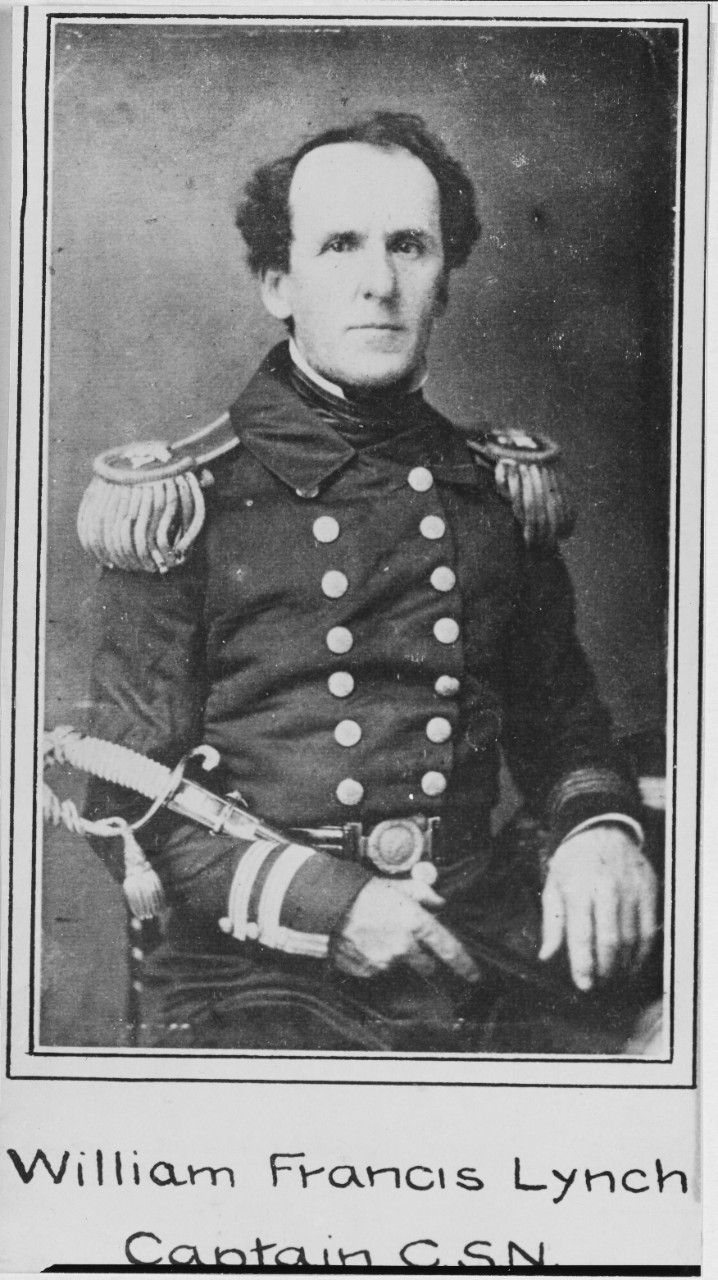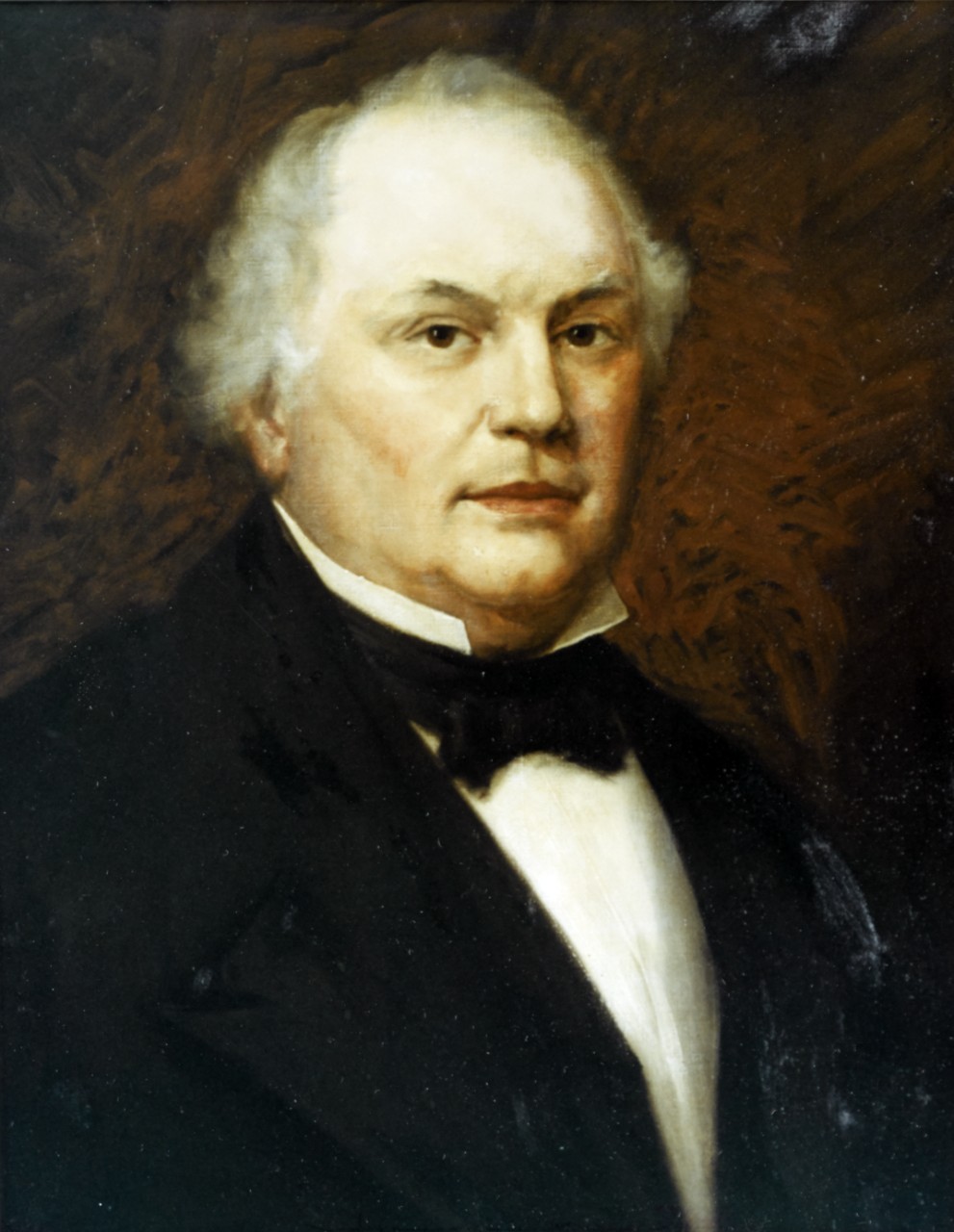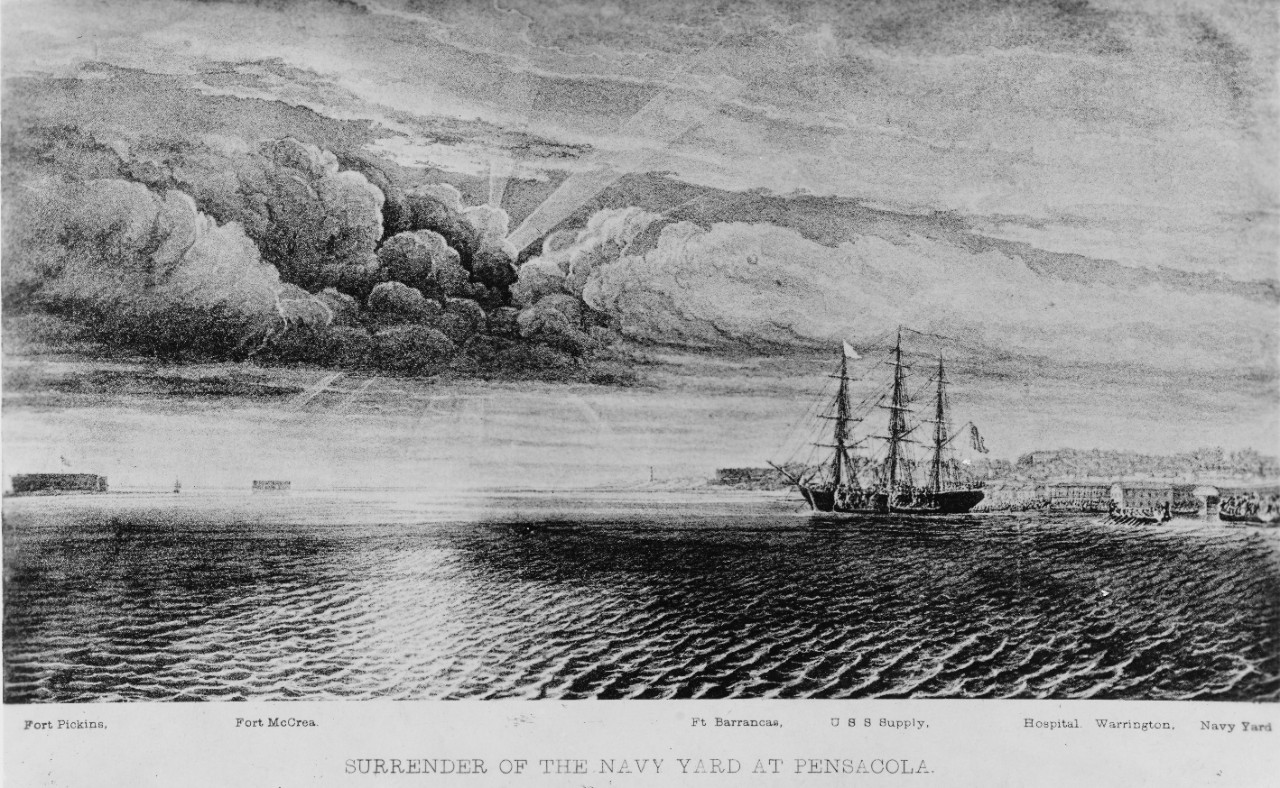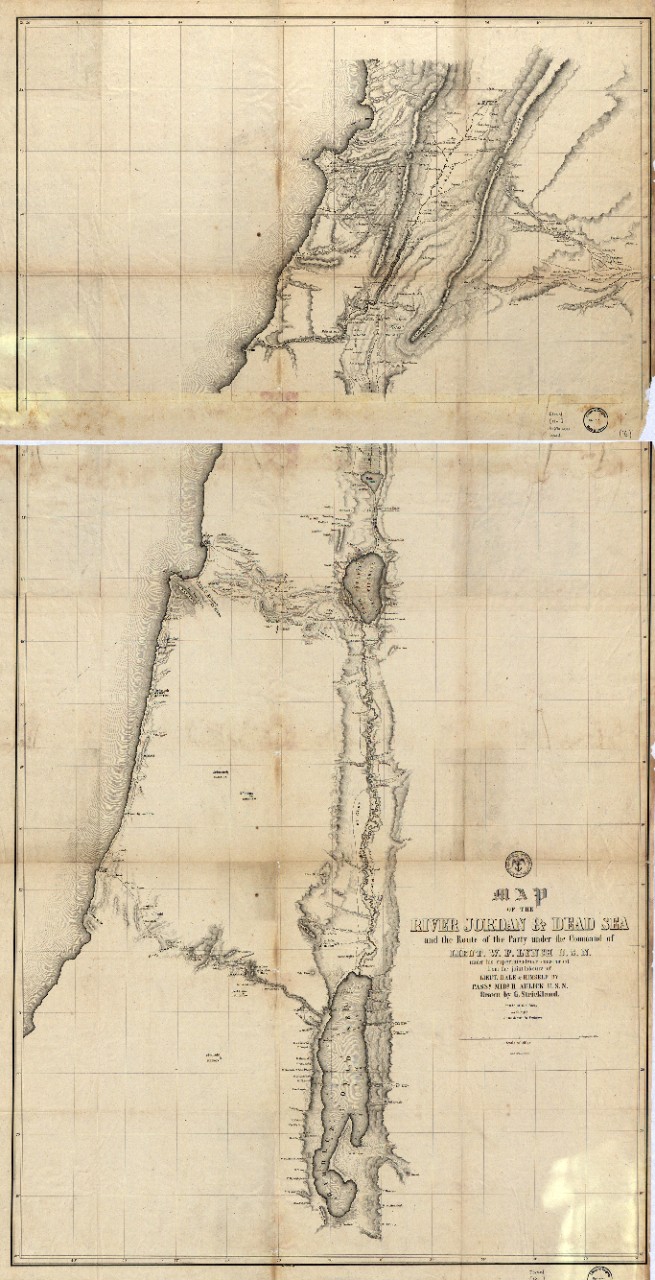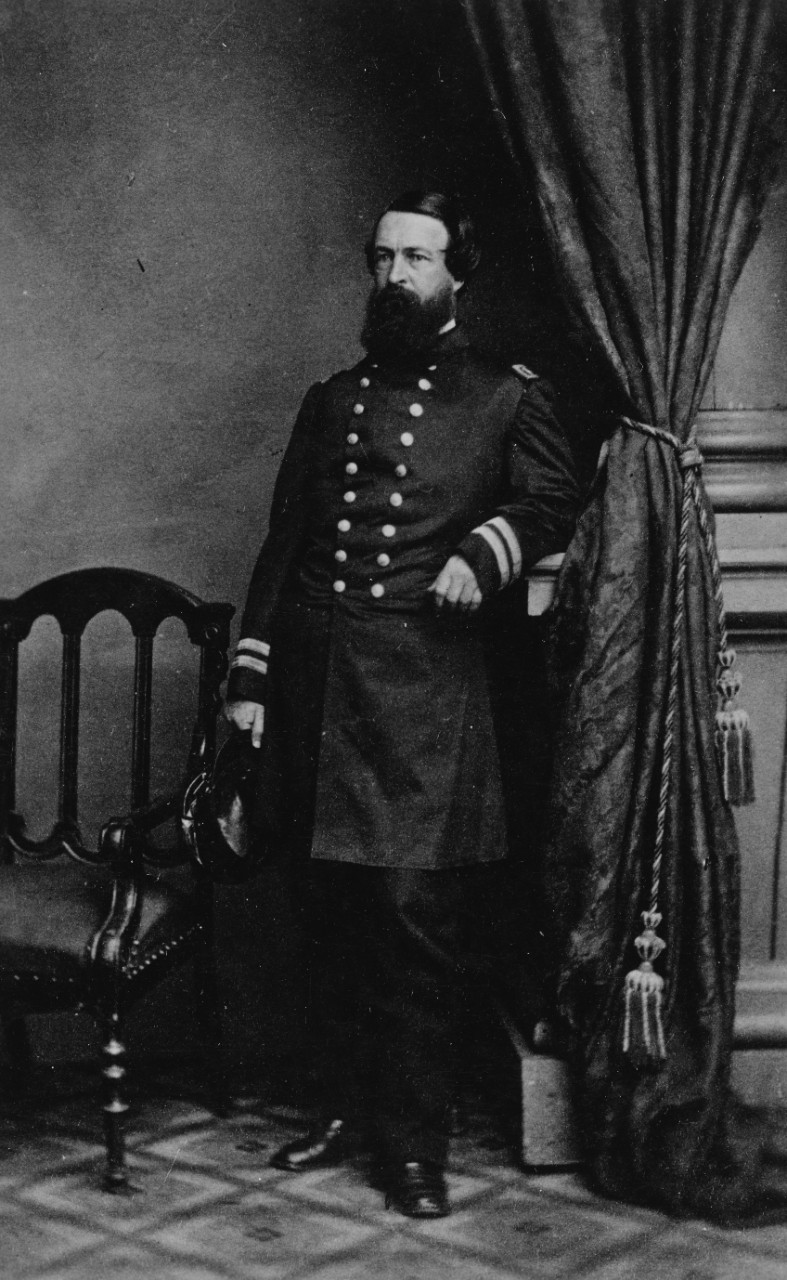Navigating the Dead Sea: 1848
This exhibit was on display from 2004 to 2005. The exhibit focused on expedition of Lieutenant William Lynch’s onboard the supply ship Supply which sailed in 1847 from Brooklyn Navy Yard to explore the Jordan River and the Dead Sea. For twelve months, the expedition contributed to the scientific knowledge of the region and returned to Hampton Roads, Virginia, in December 1848.
Secretary of the Navy John Mason approved Lieutenant William Lynch’s request to lead an expedition to explore the Dead Sea in mid-1847. Mason believed that the expedition would contribute to scientific knowledge of the ancient home of Jews, Christians, and Muslims, while elevating the U.S. Navy’s reputation abroad. Mason’s only stipulation for the expedition was that Lynch receive prior permission of Sultan Abdul Mejid, the young Turkish emperor in Istanbul, before putting his armed party ashore on Ottoman Empire lands.
Lynch had been on leave for nine months, mourning the death of his eighteen-year-old daughter, and was eager to return to naval service. The Mexican-American War was just coming to an end and there were no other challenges in sight. Lynch, a devout Catholic, saw this expedition as an opportunity to pursue his childhood dream of traveling to the Holy Land. In November 1848, he wrote to Mason: “… By your special order, I had previously contracted for two metallic boats, and while the ship was being equipped, procured mathematical instruments and various articles deemed necessary for the successful result of the contemplated attempt to descend the Jordan and explore the Dead Sea …”
Portrait of William F. Lynch
William Francis Lynch was born in Norfolk, 1 April 1801. At age 18, Lynch joined the Navy as a midshipman and became a lieutenant in 1828. Knowledgeable in many areas, including history, religion, botany, geology, and ornithology, he was eager to travel to new places. His passions, along with a talent for diplomacy, commitment to discipline, and care for his sailors, made Lieutenant Lynch the ideal leader for the Dead Sea Expedition.
Below are some items William F. Lyrnch brought with him on the expedition.
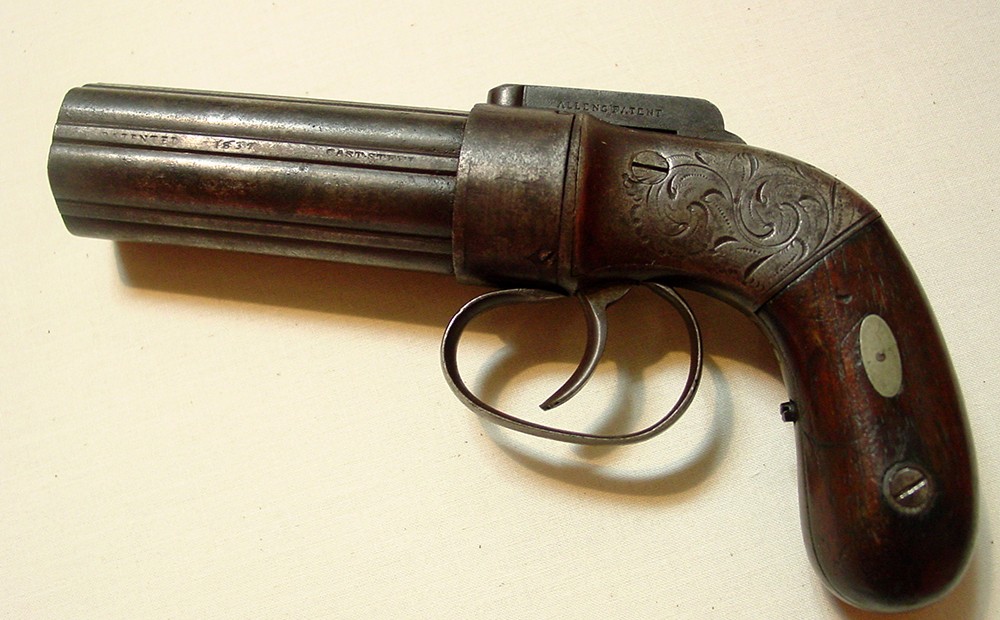
Allen’s .32 Caliber Pistol
Arthur Allen of Connecticut manufactured .32 Caliber Model, patented in 1837. Featuring a 6 shot revolving barrel, it found common use as a weapon for self-defense. Courtesy, Howard L. Wheeler.
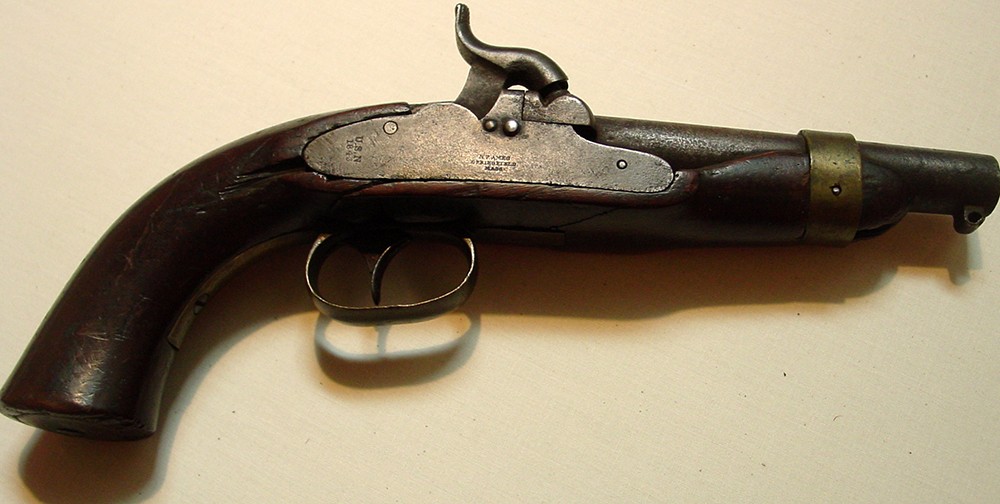
Ames Box Lock Pistol
From 1843, the Ames Company of Chicopee, Massachusetts made percussion pistols, often called box lock pistols because of the hammer being inside the lock plate. It allowed easier handling when hung from a belt. Naval History and Heritage Command Curator Branch.
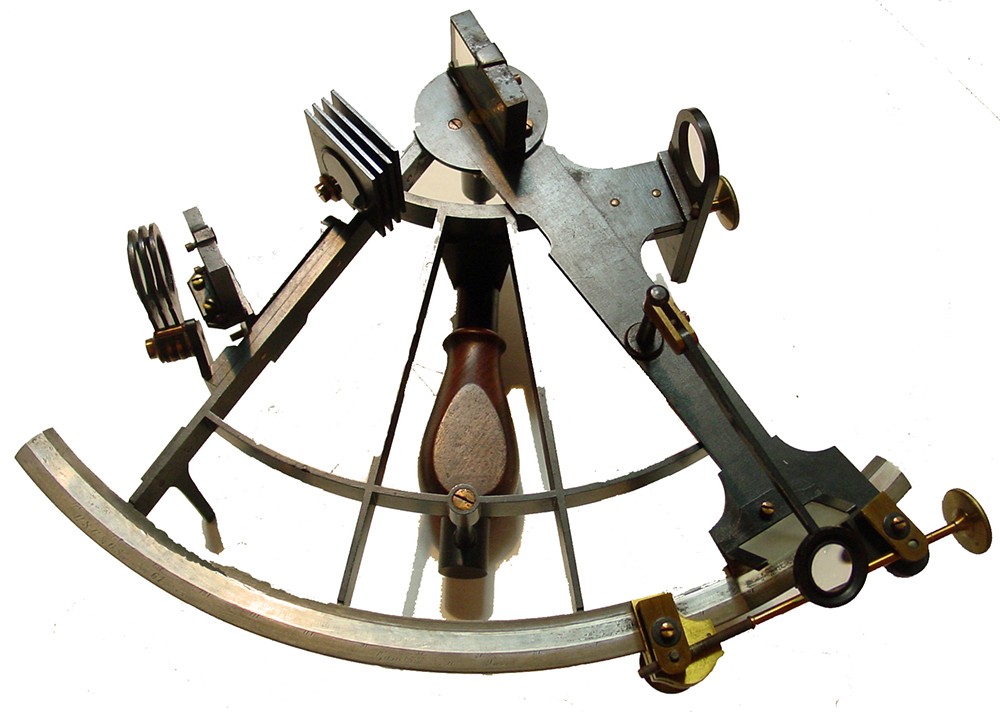
Gambey Sextant
This sextant, made by Henri-Prudence Gambey of Paris, France was used by Lynch to find the expedition’s position east of the prime meridian in Greenwich (England). Lynch used his sextant at noon each day to find the angle of the between the sun and horizon. With that information, he determined the party’s position east of the prime meridian (north-south) line in Greenwich, England. Courtesy, Smithsonian Institution, National Museum of American History. Behring Center.
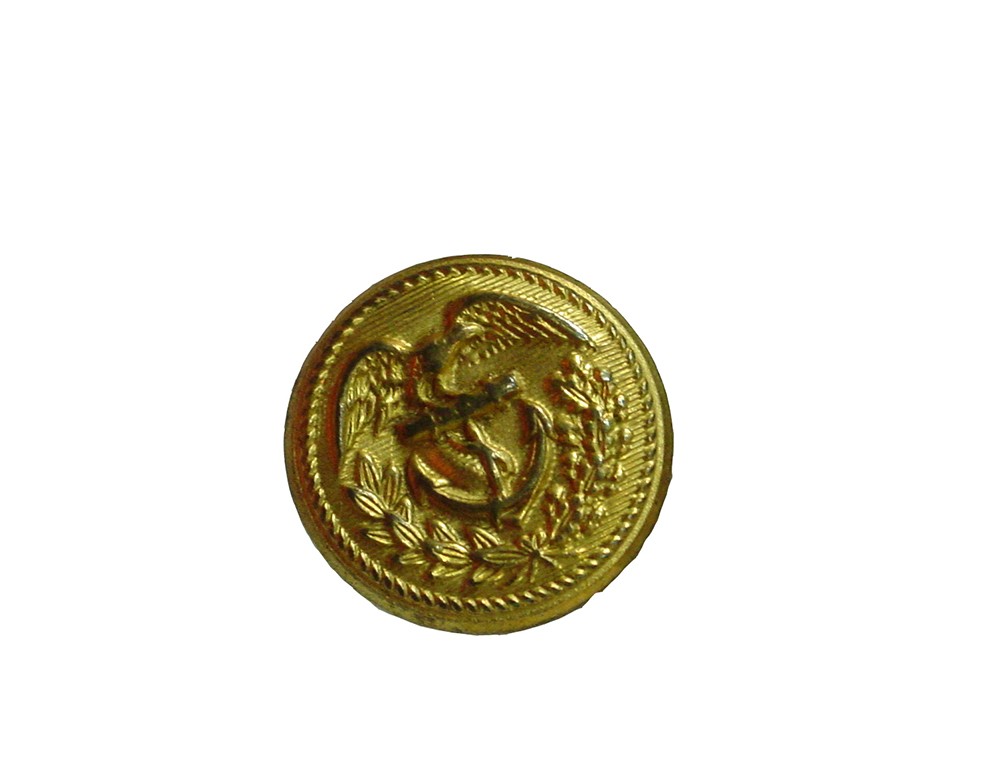
Naval Officer’s Uniform Button
This button came from the jacket of William Lynch’s U. S. Navy Uniform that he wore when meeting the Sultan Abdul Mejid. Courtesy of John Lynch, Sr.
John Y. Mason had been a successful lawyer and landowner in Virginia before becoming involved in national politics. He served as Secretary of the Navy from 1844-45, and again from 1846-1849. Mason continued the Navy’s age of scientific exploration, started by the Wilkes Expedition to Antarctica and the Pacific coast, by authorizing Lynch’s trip to the Dead Sea.
Sultan Abdul Mejid
Abdul Mejid became the sultan of the Ottoman Empire in 1839. He was a reformer and tried to improve the lives of citizens of all classes through fair taxation, equal rights, and religious freedom, while enduring interference from foreign ambassadors in international affairs. Before proceeding with the expedition, Lynch was under orders from Mason to receive a firman, or imperial passport, from the sultan. He received the necessary letter of permission to travel through the empire on 8 March 1848.
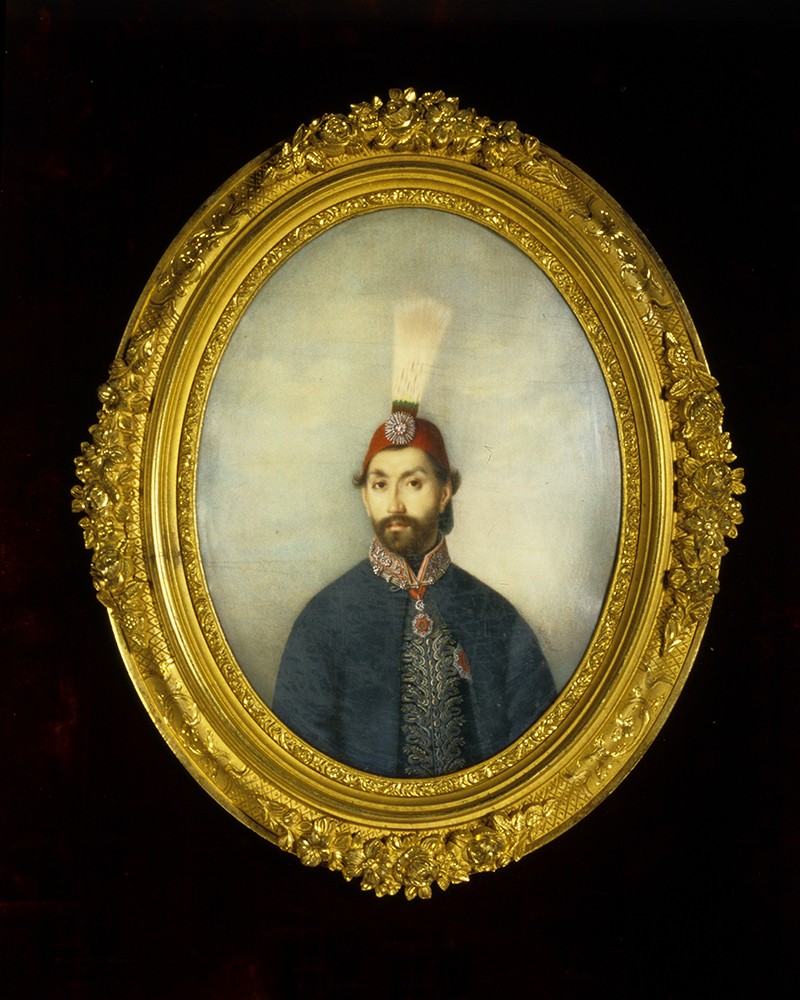
Color Miniature Portrait: Sultan Abdul Mejid. Courtesy of John Lynch, Sr.
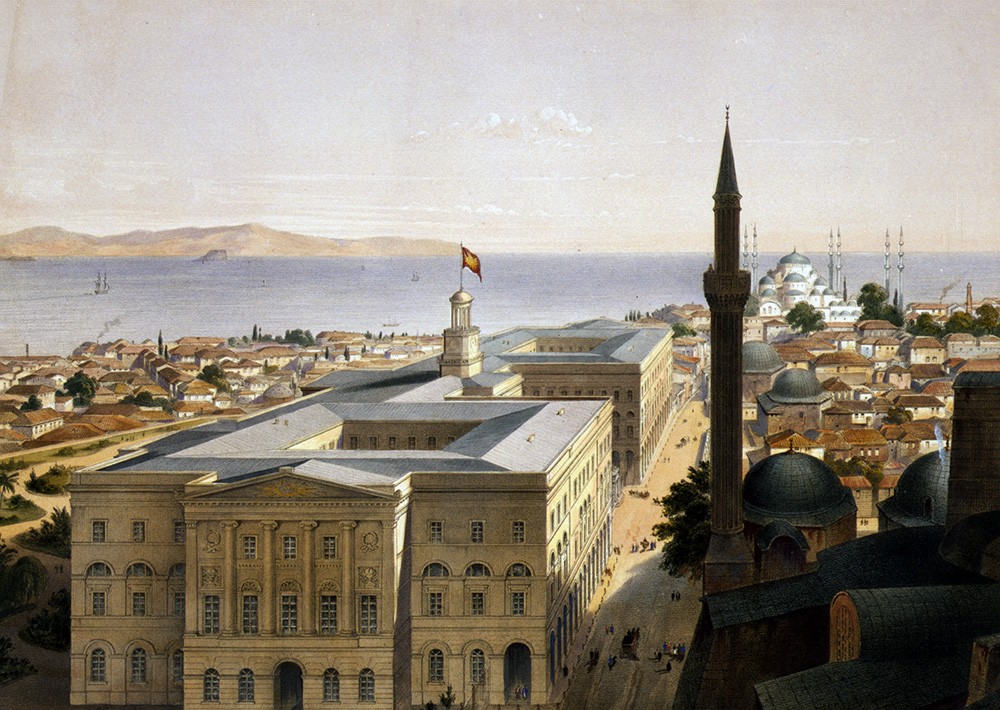
Istanbul had been the imperial capital of the Ottoman Empire for almost five hundred years when Lynch arrived in 1848. Other than his audience with the Sultan, the lieutenant treated his stay purely as a tourist, viewing many of the city’s major attractions. Gaspare Fossati, a Swiss architect who lived in the city from 1838 to 1858, produced a series of images including this one. He and his brother restored Istanbul’s great mosque, Aya Sotia, during the time of Lynch’s visit.
Image of Istanbul Courtesy of the Library of Congress, LC-USZC4-11857.
Routes, Ships Boats
Lieutenant Lynch, now in command of the storeship Supply, sailed from the Brooklyn Navy Yard on 27 November 1847. Out of the approximately forty crewmembers, ten had been specially selected by Lynch, who wrote: “I was very particular in selecting young, native born Americans, of sober habits, from each of whom, I exacted a pledge to abstain from all intoxicating drinks.”
On board the ship, in addition to the supplies carried to the U.S. Navy squadron in the Mediterranean, were two innovative, corrugated metal rowboats, Fanny Mason and Fanny Skinner. The “fannies,” as the Lynch Report referred to the boats, would carry the expedition across the Lake Tiberias, down the Jordan River, and into the Dead Sea. Lynch and his men would spend eighteen days in exploration of the ancient lake. Supply arrived at Smyrna (now Izmir) on the Turkish coast in mid-February 1848 and waited there while Lynch was in Istanbul gaining the sultan’s permission to travel through his territory. The expedition then sailed for St. Jean D’Acre, the expedition’s initial camp, via Beirut, and finally disembarked at Acre on 31 March 1848 to begin the trek to Lake Tiberias.
By the time of Supply’s transatlantic voyages for Lynch’s expedition in 1847-1848, logistic voyages by American warships to the Mediterranean Sea had become routine. Starting in 1801, they continued to sustain American warships to support the Navy’s overseas deployment against the Barbary States. Despite stormy weather, Supply made the eastbound voyage in less than four weeks and was able to return home in seven weeks the next year.
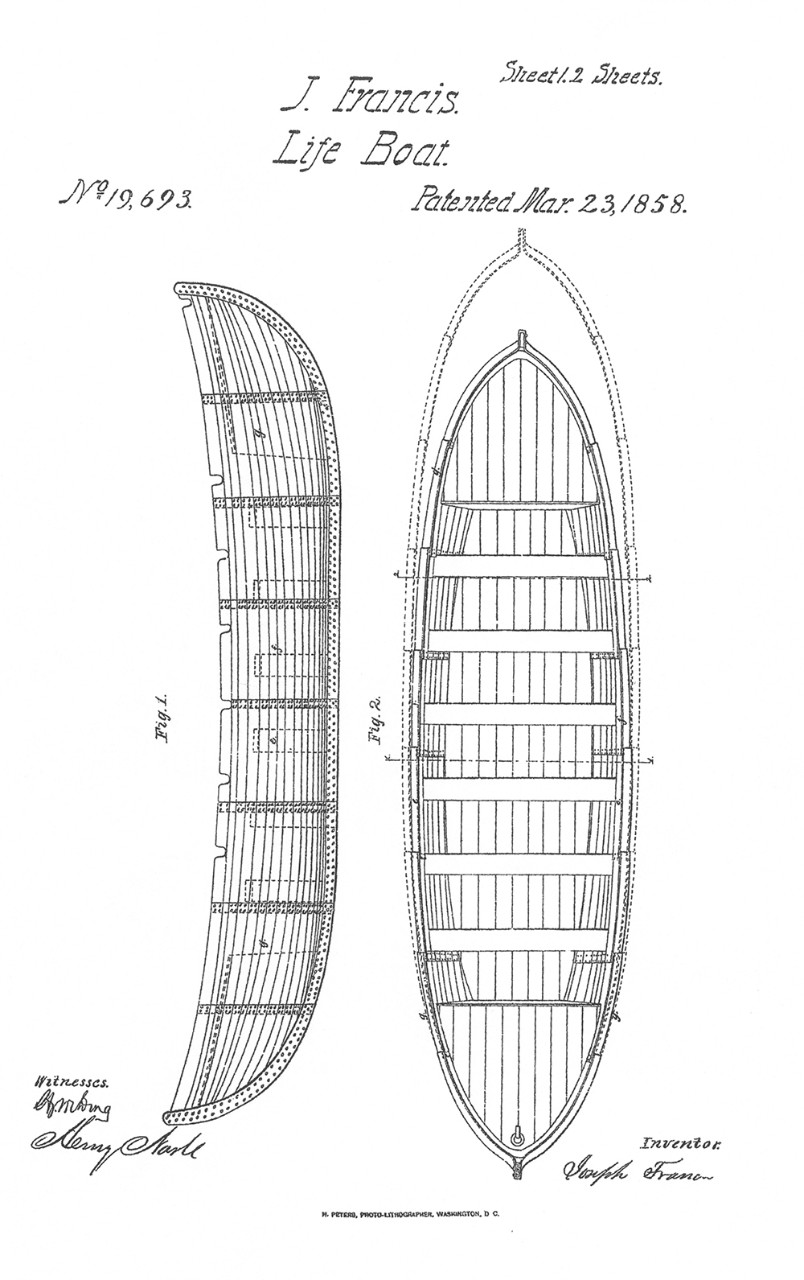
Lifeboat Patent Drawing
Inventor and manufacturer Joseph Francis designed numerous small boats and lifeboats in the 1800’s, including the used on the Lynch expedition.
Courtesy, Smithsonian Institution, National Museum of American History. Behring Center.
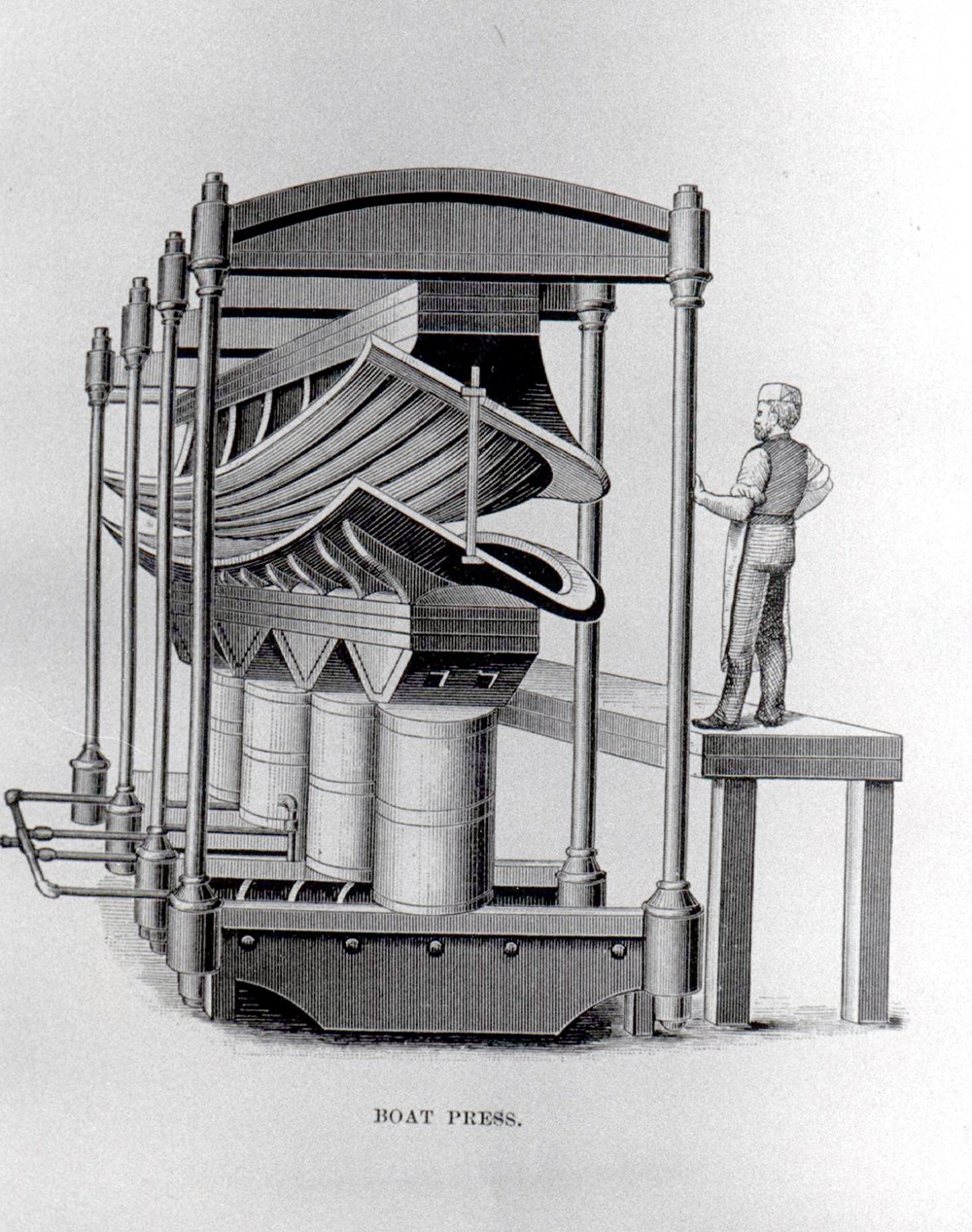
Drawing of Hydraulic Press
Manufacture of the metal rowboats, or “fannies,” used by Lt. Lynch was done by special hydraulic press.
Courtesy, Smithsonian Institution, National Museum of American History, Behring Center.
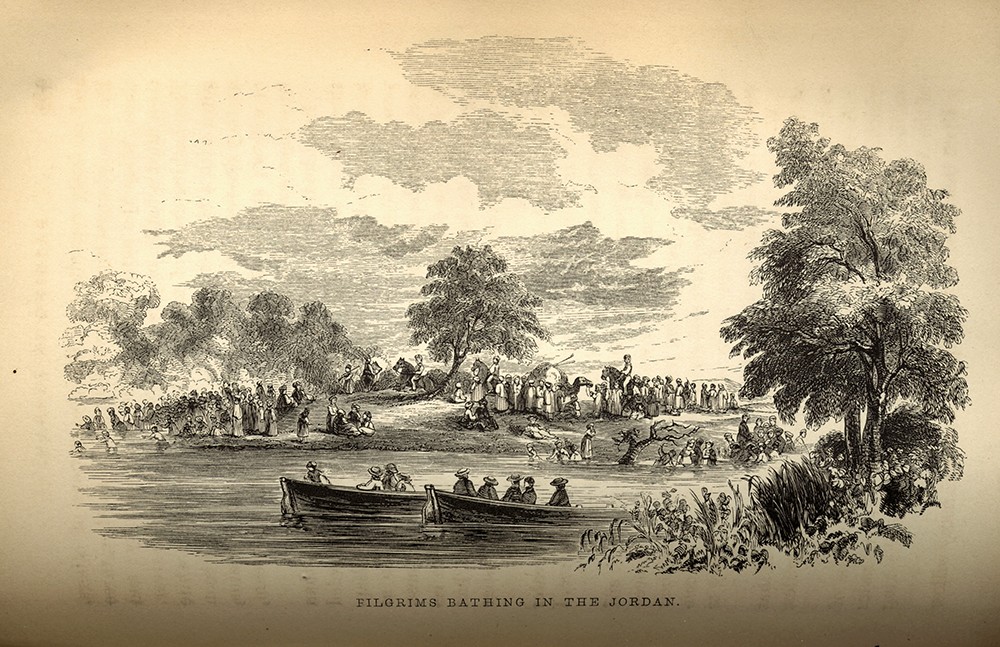
Boats on the Jordan
Lynch and Midshipmen Richmond Aulickl commanded Fanny Mason and Fanny Skinner during the descent of the Jordan River at fifteen miles per day. Although battered by the river’s rapids, the boats survived the trip unlike the newly purchased wooden Uncle Sam.
Official Report of the United States’ Expedition to explore the Dead Sea and the River Jordan by Lieutenant William F. Lynch, Pg. 262. Courtesy of the NHHC Navy Department Library.
Acre to the Dead Sea
The Holy Land of Jews, Christians, and Muslims was a dangerous place in the eyes of foreigners in 1848. During this time, the Dead Sea Valley was under Ottoman control but effectively ruled by no one. After the expedition came ashore, Lieutenant Lynch faced several daunting challenges. He had to transport the fannies and their crews some forty miles overland to Tiberias, then to the mouth of the Jordan River, down the river 130 miles to their objective, the Dead Sea. Lynch needed to do this safely, despite predatory nomadic tribes who viewed wandering Westerners as convenient prey. Mysterious, lethal diseases also afflicted the region. Lynch’s men assembled carts brought from the U.S. that, with the help of cooperative camels, carried the fannies to Lake Tiberias. To help in that process, the expedition was protected by Sheirf Hazza and ‘Akil Aga.
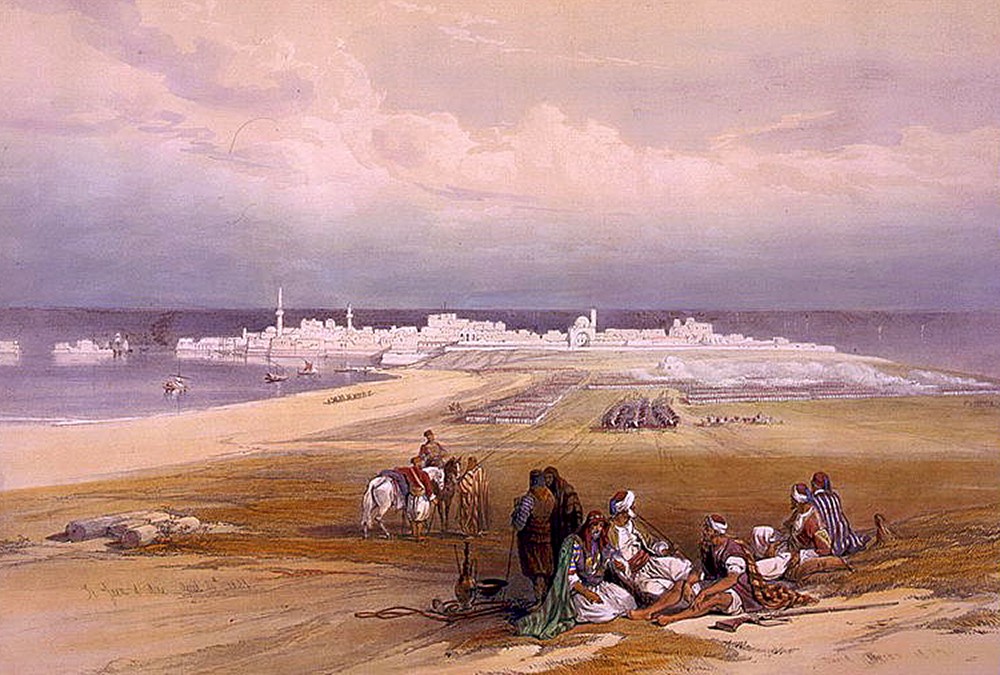
Lynch in St. Jean D’Acre
The Lynch expedition left their ship at the ancient port town of St. Jean D’Acre, shown here in a near contemporary lithograph by the Scottish artist, David Roberts. From Acre Lynch’s boats were hauled by camel cart to Tiberias. Watercolor. Courtesy, Tom Freeman
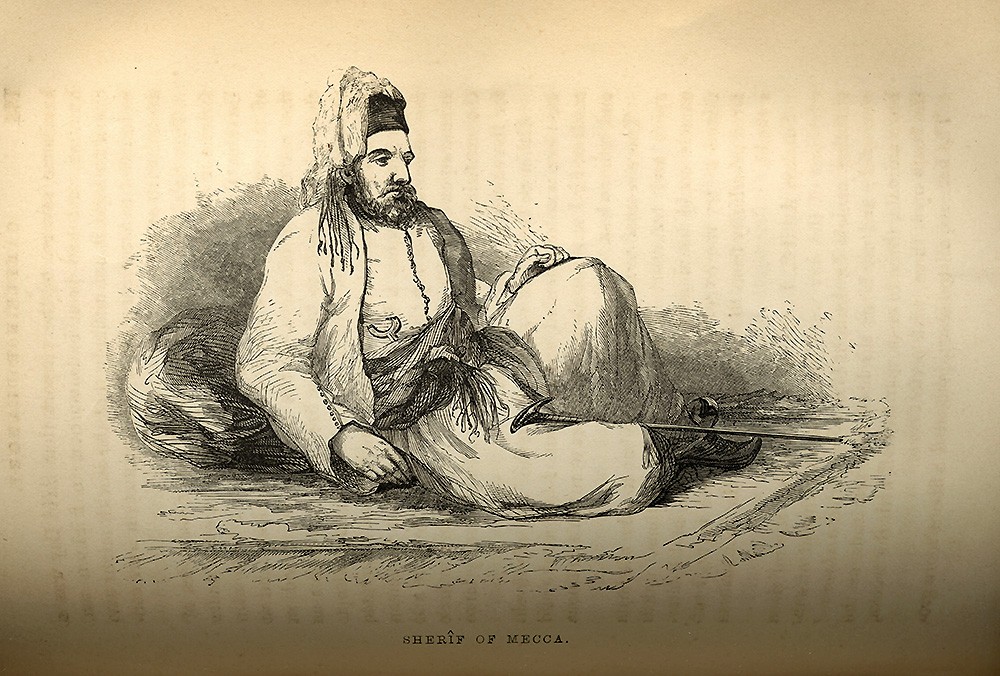
Sheriff of Mecca
Lynch hired two Muslim leaders and their troops to accompany his small group as bodyguards. His senior escort, Sherif Hazza of Mecca was a direct descendant of Mohammed.
Official Report of the United States’ Expedition to explore the Dead Sea and the River Jordan by Lieutenant William F. Lynch, Pg. 134. Courtesy of the NHHC Navy Department Library.
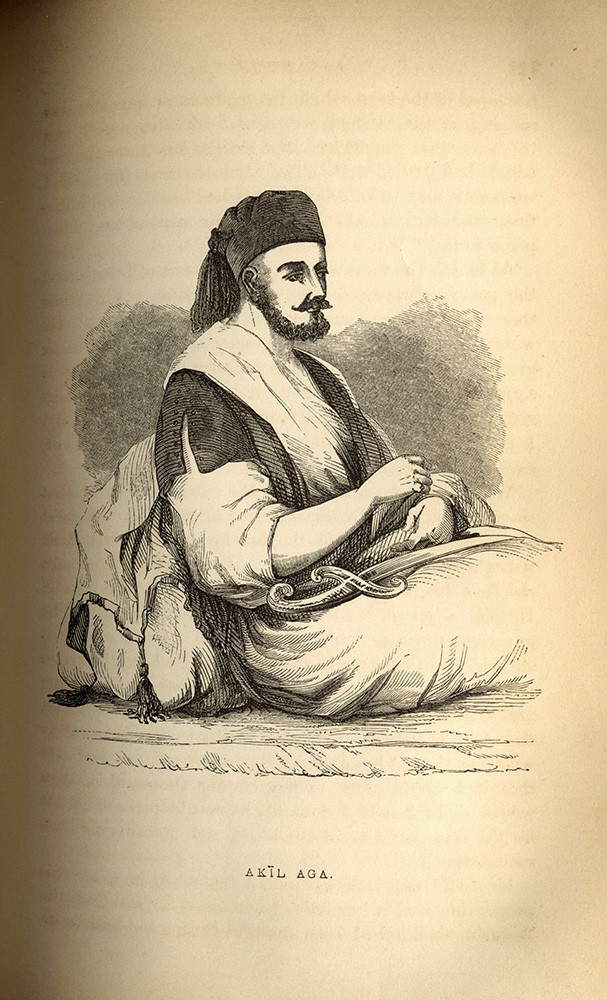
Mustafa the Cook
The Reverend Eli Smith of the American Presbyterian Mission in Beirut recommended the Arab cook Mustafa to Lynch. He earned his pay providing the officers of the expedition (enlisted men cooked for themselves) with food – even roasting lamb in a windstorm.
Official Report of the United States’ Expedition to explore the Dead Sea and the River Jordan by Lieutenant William F. Lynch, Pg. 128. Courtesy of the NHHC Navy Department Library.
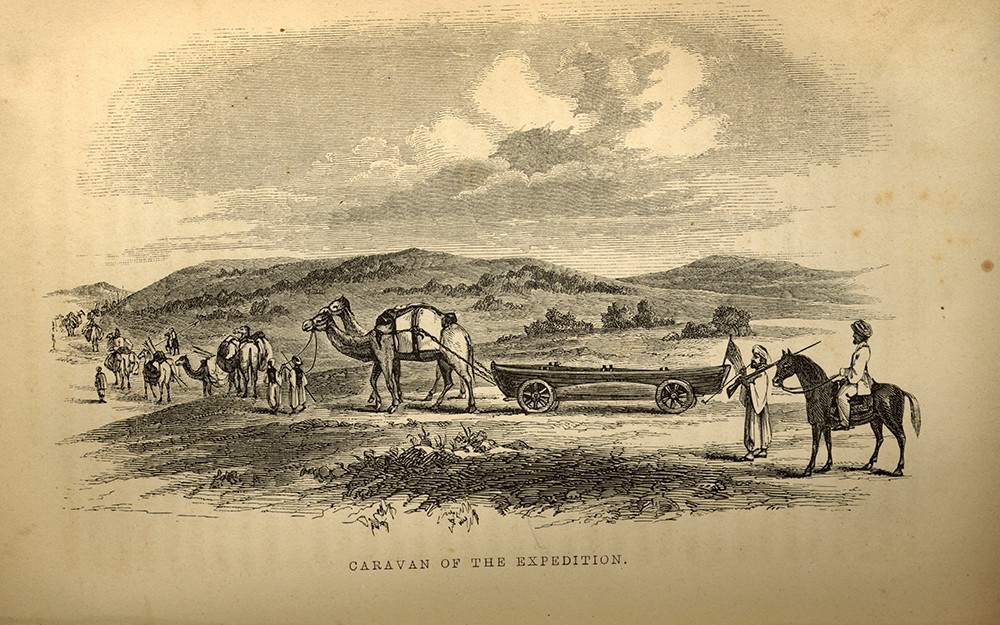
Transporting the Fannies
At first Lynch hired horses to move the fannies from the coast to the Jordan River. The only ones available, trained as mounts, refused to move the boats. As a last resort, he hired camels, which worked well, except in rough terrain when only human muscle served.
Official Report of the United States’ Expedition to explore the Dead Sea and the River Jordan by Lieutenant William F. Lynch, Pg. 146. Courtesy of the NHHC Navy Department Library.
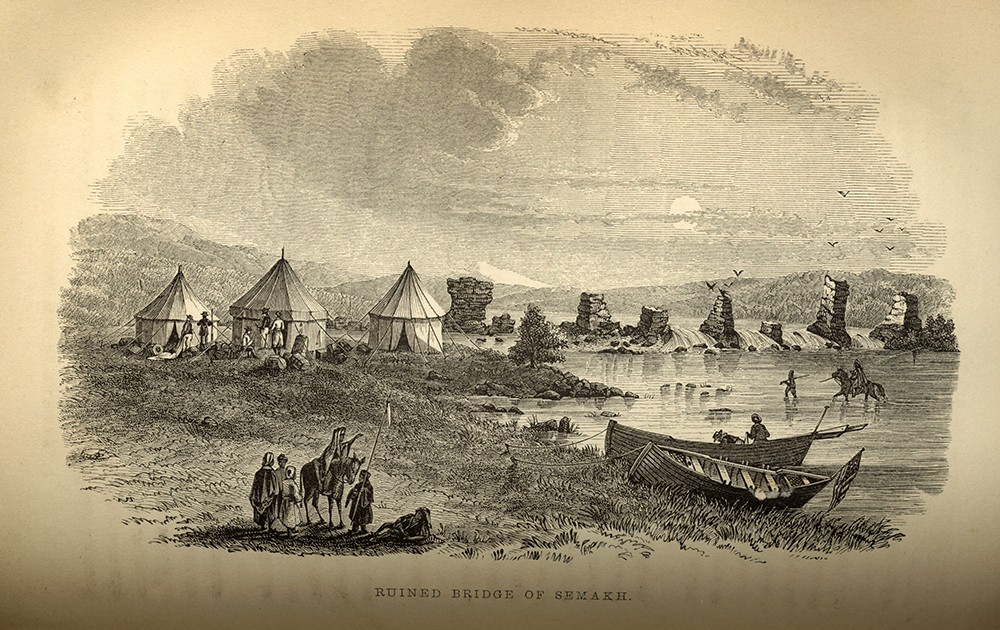
Encampment on the River Belu.
During the descent of the Jordan, Lynch’s men pitched their tents on River Belus, a tributary. Their two American, one Arab, and one Egyptian tent must have attracted considerable interest from the natives.
Official Report of the United States’ Expedition to explore the Dead Sea and the River Jordan by Lieutenant William F. Lynch, Pg. 176. Courtesy of the NHHC Navy Department Library.
The Dead Sea
Other Westerners explored the region during the 19th Century. Most were searching for scientific knowledge regarding minerals, plants, and animals. Many also sought religious insight. Lynch and his crew performed both of these tasks: collecting samples of minerals, and plants, mapping their geographical locations, and determining the depth of the sea while also in search of the location of Sodom and Gomorrah. Careful soundings revealed that the bottom of the north basin was one hundred times as deep as that of the south. Lynch believed that the two cities lay under the shallow south basin.
Terrible hot winds, declining health, and simple curiosity drove Lynch’s party to occasional side explorations to the highlands above the valley. Some visited the ancient fortress site of Masada; all went to Kerak. Birds flying overhead disproved the old belief that nothing living could pass over the Dead Sea without dying. Lynch’s discoveries went far to correct such superstitions about the region. Lynch felt the words of the Holy Scripture were confirmed and his powerful faith remained unshaken.
Dead Sea Map. The route of Lieutenant Lynch constructed by Lieutenant Dale and Midshipmen Aulick, circa 1848. Courtesy of the Library of Congress. G7512.j6 184-US.
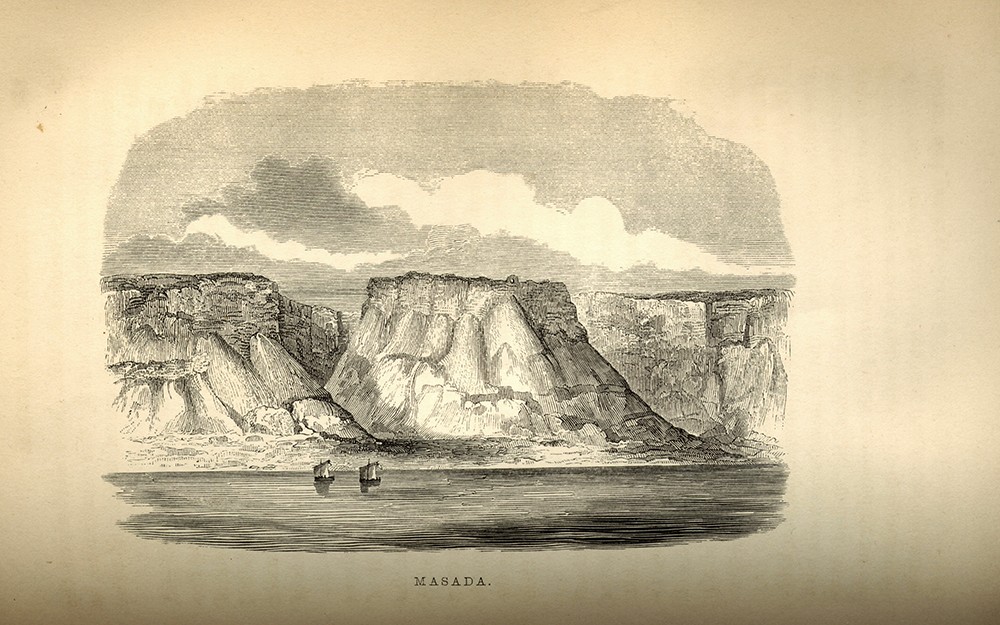
Masada
A decade before Lynch reached the Dead Sea two Americans had identified the butte of Sebbeh as Masada, where the Jewish garrison had chosen suicide over capture by the Romans in 73 A.D. Lynch sent three members of his group to explore the site.
Official Report of the United States’ Expedition to explore the Dead Sea and the River Jordan by Lieutenant William F. Lynch, Pg. 333. Courtesy of the NHHC Navy Department Library.
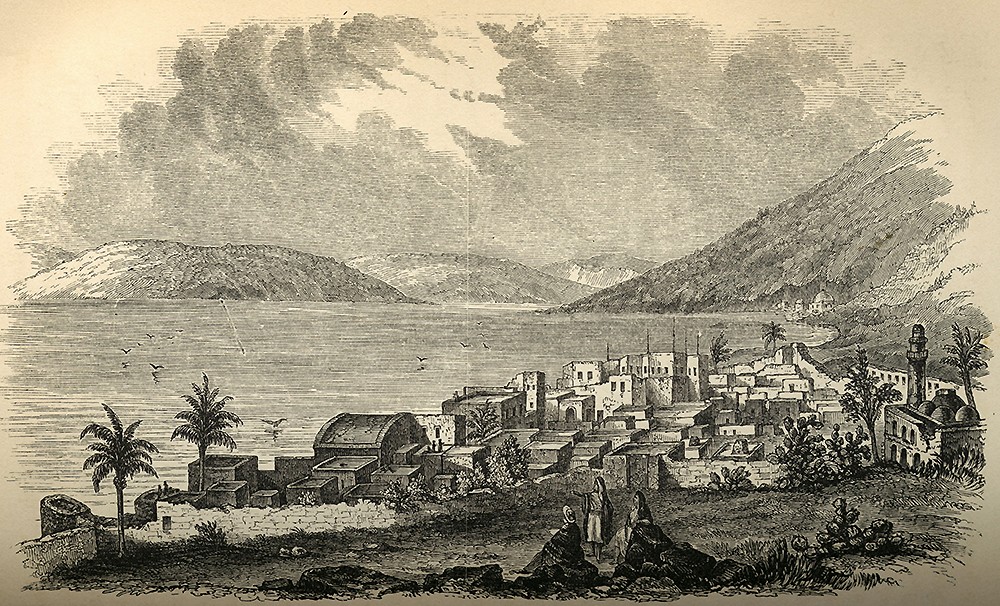
Town of Tiberias
The expedition reached Tiberias on the Sea of Galilee on April 7, 1848.
Official Report of the United States’ Expedition to explore the Dead Sea and the River Jordan by Lieutenant William F. Lynch. Courtesy of the NHHC Navy Department Library.
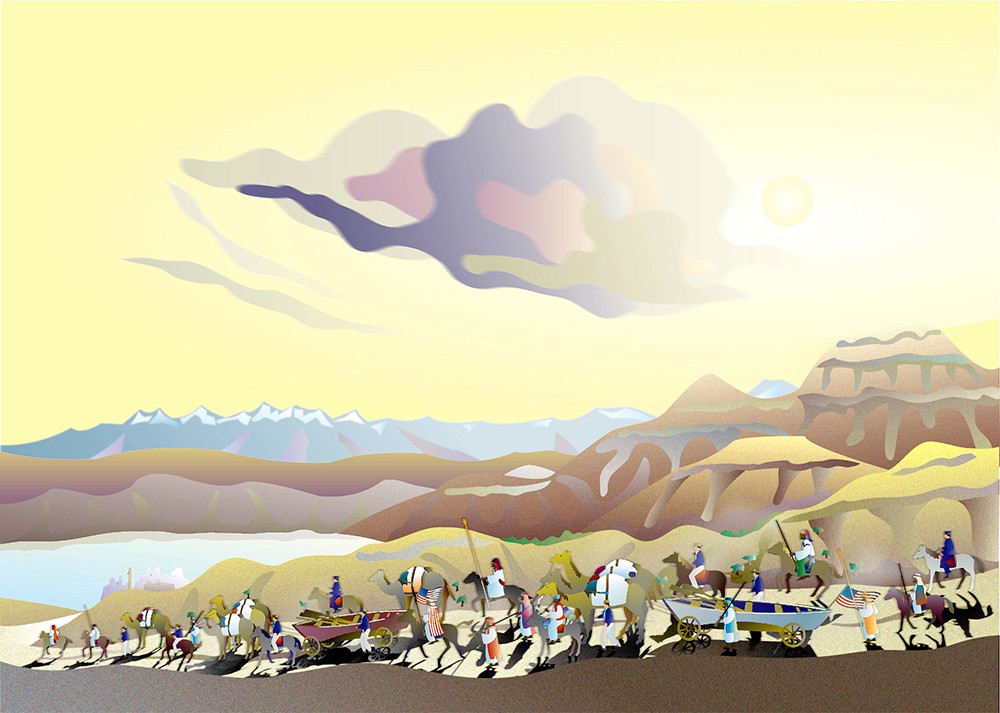
The Procession by Bob Bausch
Modern illustration depicting the expedition descending out of the hills into the town of Tiberias on the Sea of Galilee. Courtesy of John Lynch, Sr.
Survey of the Holy Land
With the loss of both mountain barometers even before the descent of the Jordan was completed, and the destruction of the barometer in a wind storm the day before the expedition left the Dead Sea, Lynch anticipated to leave ahead of schedule. With soundings taken and the survey of the Dead Sea complete despite all these technical problems, all that remained of Lynch’s assignment was the careful work of measuring the differenced in relative elevation between the Dead Sea and the Mediterranean to the west. On 24 May 1848 the crew saw the “glorious” Mediterranean for the very first time since they had turned their backs to it seven weeks ago.
Four days later, after many careful sightings over thirty-three miles of barren ground, Lieutenant Lynch’s party arrived in Jaffa and established that the Dead Seas lay exactly 1,316.7 feet below the Mediterranean. Their route from the Dead Sea to Jaffa had taken the Americans through Jerusalem, a city sacred to Christians, Jews, and Muslims alike.
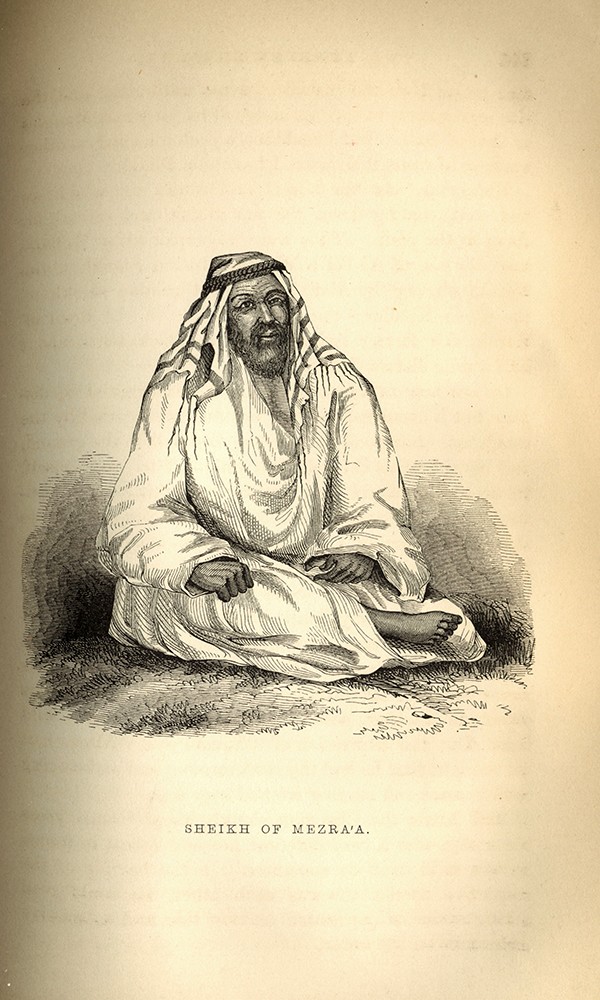
Sheik of Mezra’a
Lynch’s Narrative describes two sheiks: one Muslim and one Christian. His account does not clarify which of these two is depicted in this image.
Official Report of the United States’ Expedition to explore the Dead Sea and the River Jordan by Lieutenant William F. Lynch, Pg. 346. Courtesy of the NHHC Navy Department Library.
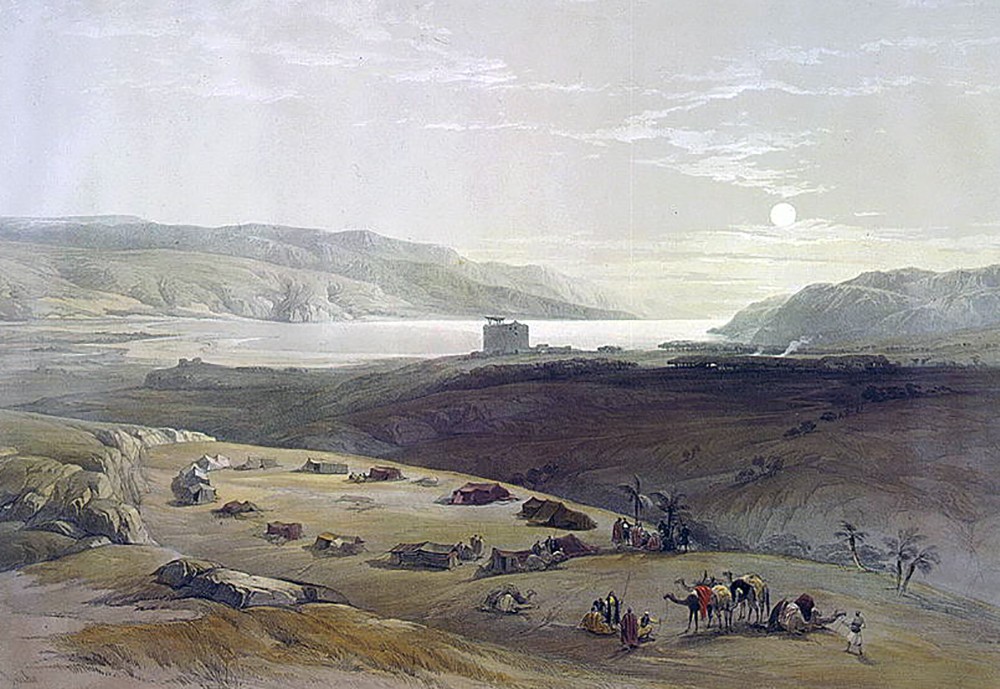
Jericho April 3rd 1839
David Roberts
The ancient ruins at Jericho reinforced Lynch’s belief that the Biblical cities of Sodom and Gomorrah also existed. The landscape around Jericho is typical of the terrain traversed by Lynch and his expedition during their survey from the Dead Sea to the Mediterranean Coast.
Courtesy of the Library of Congress, LC-USZC4-3469.
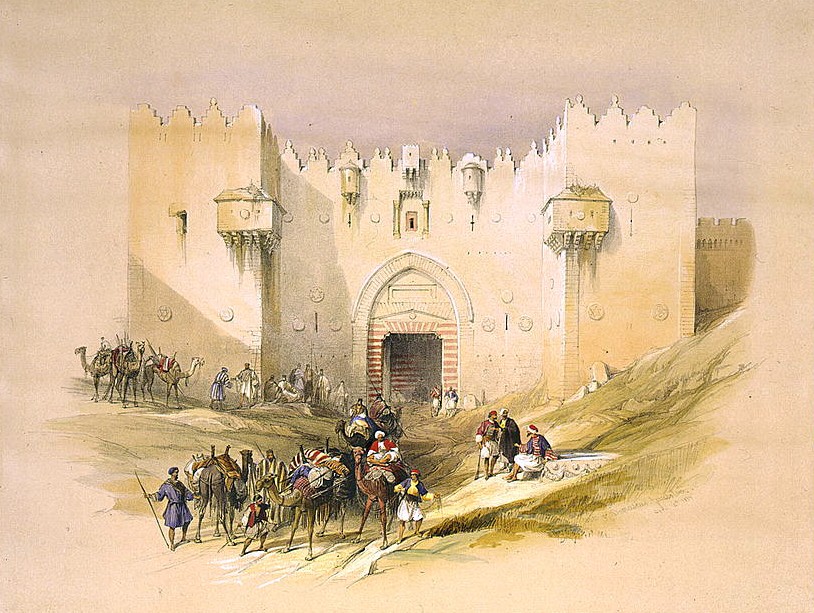
Gate of Damascus Jerusalem April 14th 1839
David Roberts
In 1848, Jerusalem had four functioning gates set in the 60 to 70 foot high walls: the Damascus Gate on the road leading north, the St. Stephen Gate on the eastern road, the Zion Gate to the south road, and the Jaffa Gate for the western road. The Golden Gate on the city’s east side had been blocked up centuries before.
Courtesy of the Library of Congress , LC-USZC4-3426.
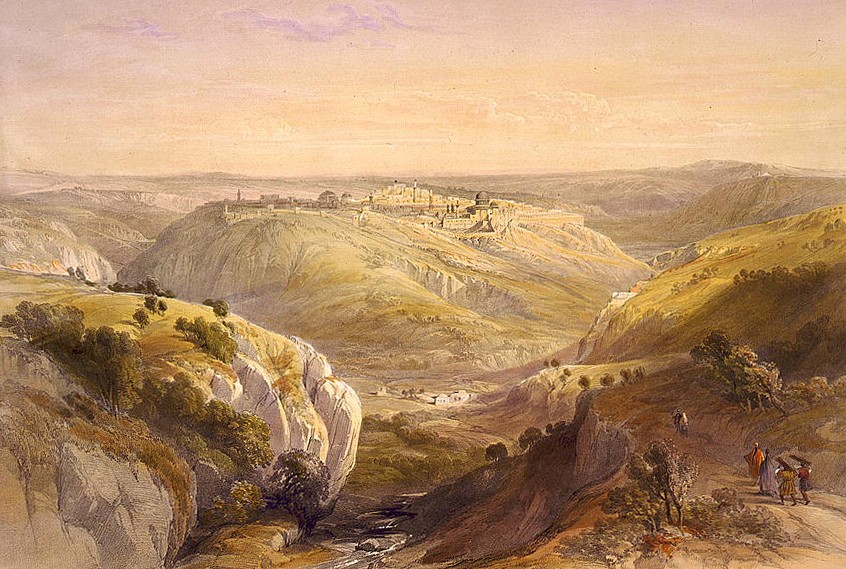
Jerusalem from the South, April 12th, 1839
By David Roberts
Courtesy of the Library of Congress, LC-USZC4-3431.
Leveling and Home
From Jaffa, the expedition headed on a roundabout path back to Beirut. The expedition left Ballbec for its last day’s ride on 29 June, in a departure that resembled an evacuation more than it did a late stage in a circuit ride. On 30 June, the men exhausted from their travels and ailing from disease, were heartbroken to discover Supply was not in the harbor waiting for them as expected. Lynch wrote, “my heart sank within me as, after many alterations of hope and fear, the only three-masted vessel in the port proved not to be Supply. The end who could foresee!” The ship had been delayed for just over one month due to more pressing naval duties. When Supply finally arrived, the members of the expedition were excited to load up their instruments and samples and start the journey home. Five months after rejoining their ship Lynch’s crew and the expedition’s specimens finally arrived in Hampton Roads, Virginia with their mission complete.
Last Leg Before Home
From Jaffa, the expedition headed on a roundabout path back to Beirut. The expedition left Ballbec for its last day’s ride on 29 June, in a departure that resembled an evacuation more than it did a late stage in a circuit ride. On 30 June, the men exhausted from their travels and ailing from disease, were heartbroken to discover Supply was not in the harbor waiting for them as expected. Lynch wrote, “my heart sank within me as, after many alterations of hope and fear, the only three- masted vessel in the port proved not to be Supply. The end who could foresee!”
The ship had been delayed due to more pressing naval duties. Due to medical advice that his ailing crewmen would grow better at sea, Lynch chartered a French brig to sail to Malta. After a painfully slow trip they reached the island. Supply arrived two days later, the members of the expedition were excited to load up their instruments and samples and start the journey home. Three months after rejoining their ship, Lynch’s crew and the expedition’s specimens finally arrived in Hampton Roads, Virginia, with their mission complete.
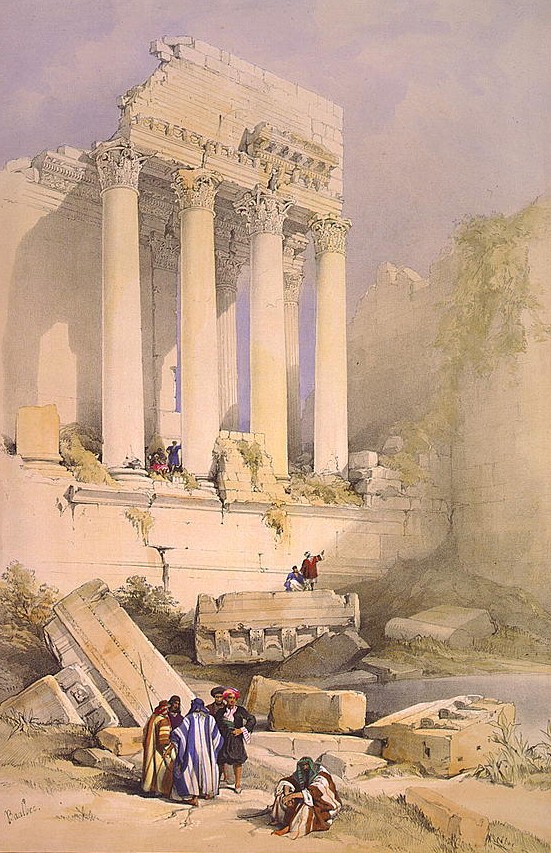
Baalbec May 4th 1839
David Roberts
The party camped within sight of the Ruins of Baalbec, sometimes spelled Baalbek, for a night. Illness of many of the crew prevented them from exploring the extensive ruins.
Courtesy of the Library of Congress, LC-USZC4-3497:
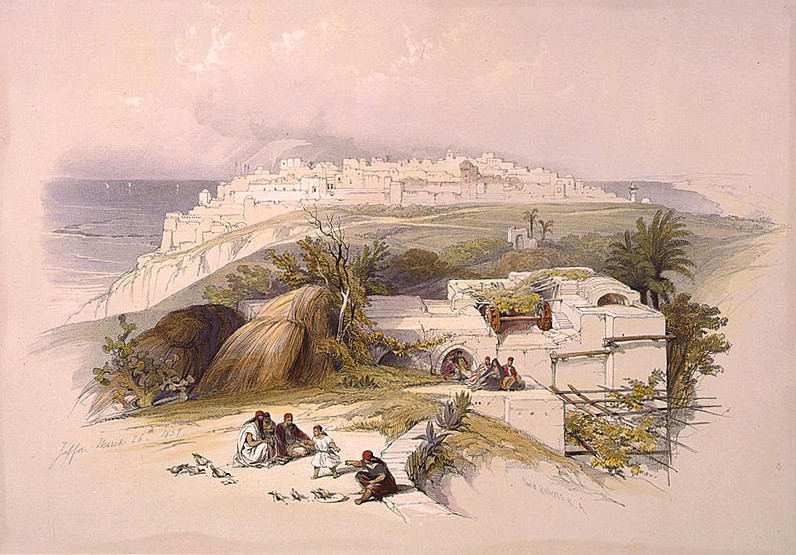
Jaffa March 26th 1839
David Roberts
The Lynch party rested a week in Jaffa reviewing the scientific records that the expedition had accumulated. The crew relaxed in an orchard owned by the American consul, Murad Scrapionis.
Courtesy of the Library of Congress, LC-USZC4-3480:
Impact of the Expedition
Lynch conducted his expedition according to the scientific practices of the day. Lynch’s careful
observations debunked many of the myths and legends that had enshrouded the Dead Sea since medieval times. His accurate descriptions of the geology and topography of the area were helpful to scientists for years to come. Yet, along with the two fannies, his expedition’s souvenirs disappeared. With the assistance of a crewmember, Lieutenant Lynch soon finished writing the expedition’s official reports in Philadelphia.
Upon the completion of Lynch’s expedition, others were drawn to the area. Lynch and his crew led the way for further scientific study. Soon to follow was an interest in travel and tourism in the area. Herman Melville and Mark Twain were among the visitors.
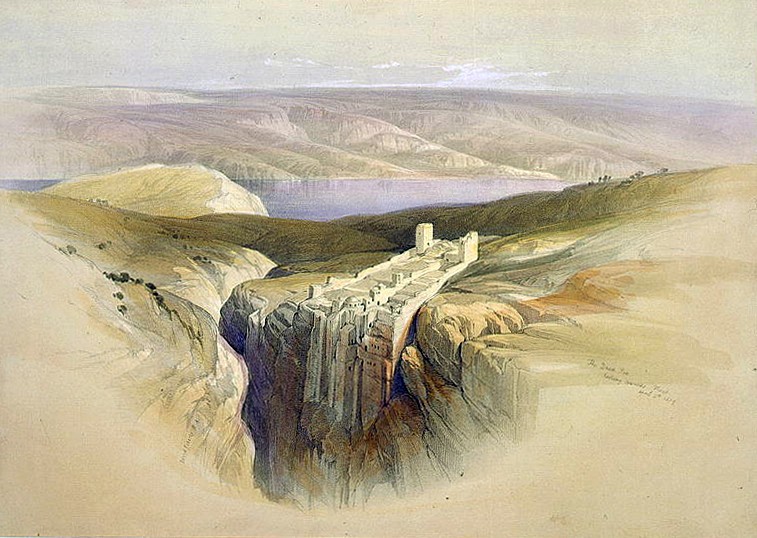
Dead Sea Looking Towards Moab, April 4th, 1839
By David Roberts
The British artist David Roberts depicted the Dead Sea a decade before Lynch arrived. While dissolved solids (magnesium chloride, calcium, sodium and potassium salts) compose one-third of the sea, the water is clear, and its color comes from the reflected sky.
Courtesy of the Library of Congress, LC-USZC4-3470.
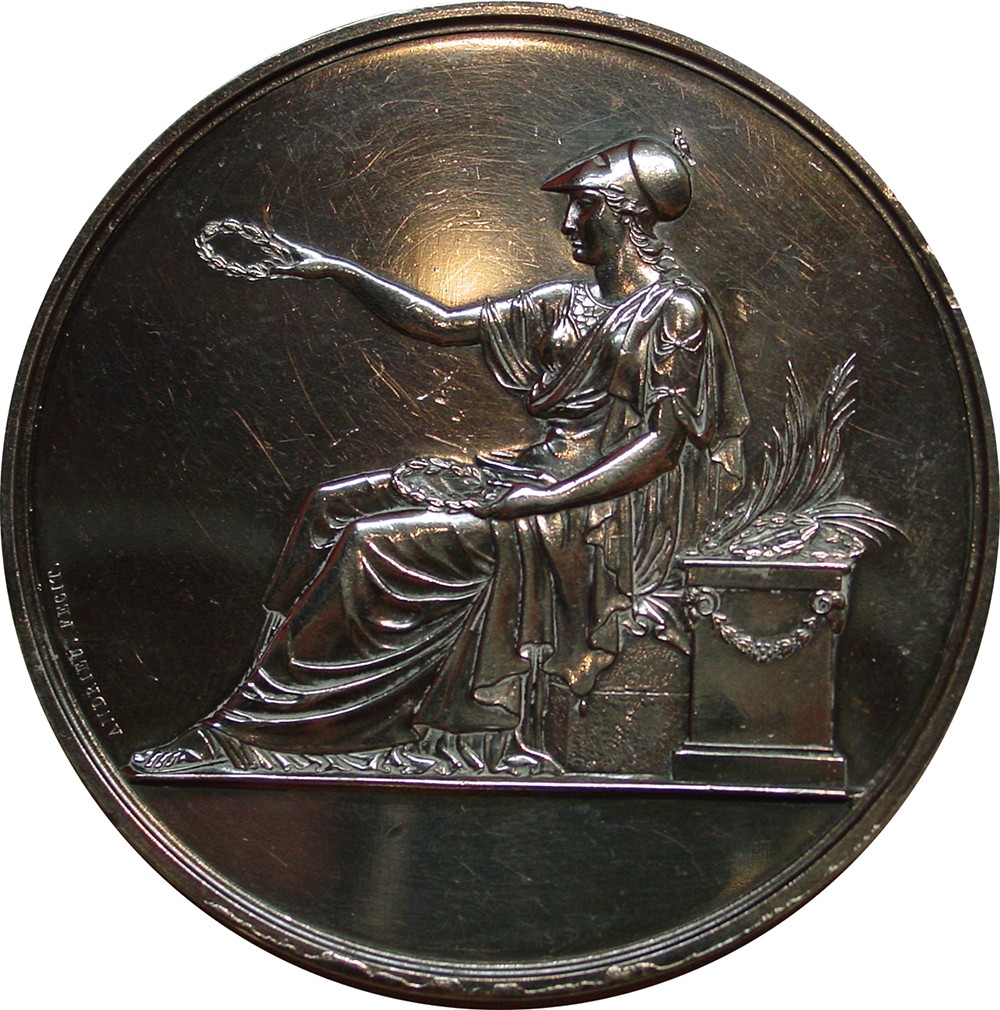
Societe de Geographie de France medal
For his exploration of the Jordan Valley and Dead Sea, the Societe de Geographie de France presented Lynch with one of its silver medals in 1851. In its reports, the Royal Geographical Society (of Britain) also recognized the value of Lynch’s survey of the Dead Sea. His activities enhanced European views of the quality of the American scientific work. Obverse side. Courtesy of Thelma Weitzner Corwin in memory of Adolph Weitzner.
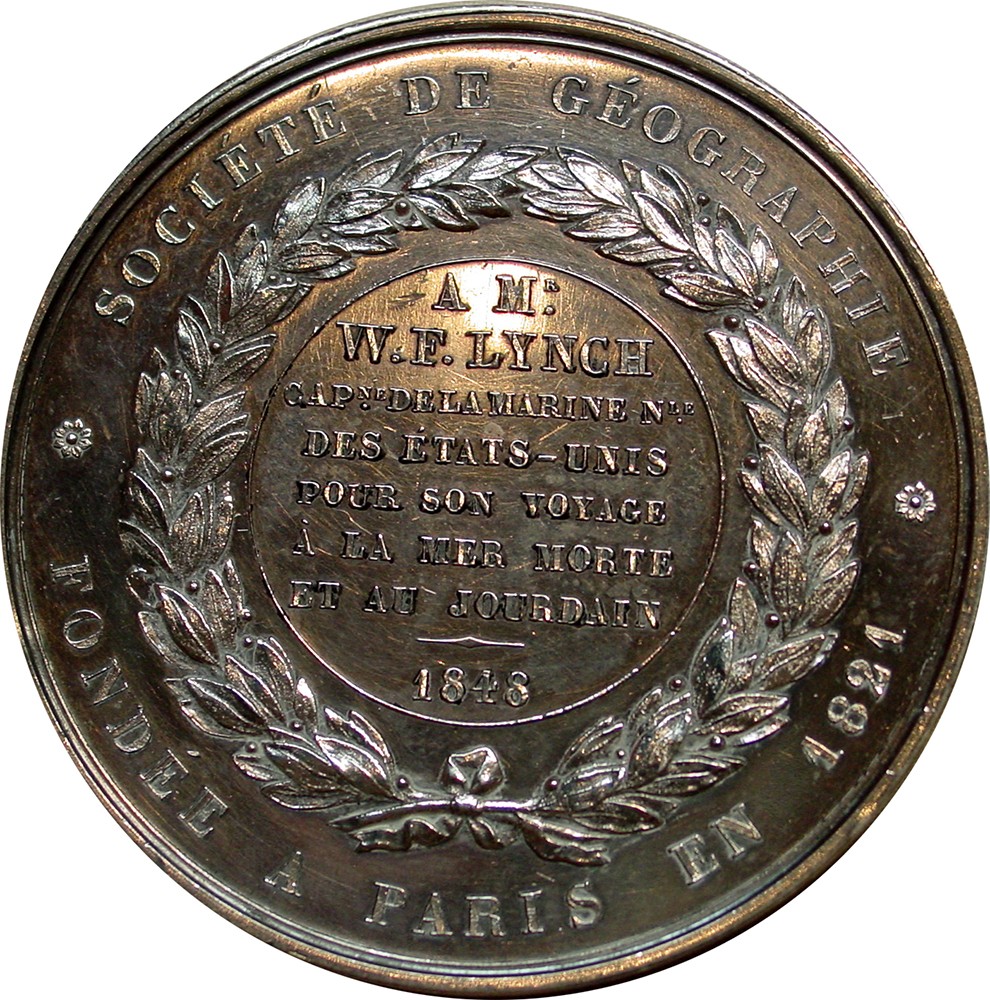
Societe de Geographie de France medal
For his exploration of the Jordan Valley and Dead Sea, the Societe de Geographie de France presented Lynch with one of its silver medals in 1851. In its reports, the Royal Geographical Society (of Britain) also recognized the value of Lynch’s survey of the Dead Sea. His activities enhanced European views of the quality of the American scientific work. Reverse ide. Courtesy of Thelma Weitzner Corwin in memory of Adolph Weitzner.
Translation: “A.F. Lynch, Captain, U.S. Navy, for his voyage to the Dead Sea and the River Jordan, 1848”
Literary Depictions
“Still no Jerusalem came in sight. We hurried on impatiently. We halted a moment at the ancient Fountain of Beira, but its stones, worn deeply by the chins of thirsty animals that are dead and gone centuries ago, had no interest for us – we longed to see Jerusalem. We spurred uphill after hill, and usually began to stretch our necks minutes before we got to the top -- but disappointment always followed: -- more stupid hills beyond -- more unsightly landscape -- no Holy City.
“At last, away in the middle of the day, ancient bite of wall and crumbling arches began to line the way -- we toiled up one more hill, and every pilgrim and every sinner swung his hat on high! Jerusalem!
“Perched on its eternal hills, white and domed and solid, massed together and hoped with high gray walls, the venerable city gleamed in the sun. So small! Why, it was no larger than an American village of four thousand inhabitants, and no larger than an ordinary Syrian city of thirty thousand. Jerusalem numbers only fourteen thousand people.”
Innocents Abroad by Mark Twain, 1869
For Judah here --
Let Erebus her rival own:
‘Tis horror absolute - severe,
Dead, livid, honeycombed, dead fell --
A caked depopulated hell;
Yet so created, judged by sense,
And visaged in significance
Of settled anger terrible.
Clarel by Herman Melville, 1876
Hi Jolly Monument
Following Lynch’s expedition in February 1856, the War Department experimented with imported 21 camels for use in the American West. Quartzsite, Arizona is the final resting place of Hi Jolly, the chief camel driver for the U.S. Camel Corps. Topsy, the last of the camels used in service of the United States government, is also buried here. Supply was the ship used to bring the camels to the United States during two voyages under the command of Lieutenant David Dixon Porter.
Commander David Dixon Porter, USN (1813-1891). Photographed in 1861-62. The original is a carte de visite print, published by E. Anthony, 501 Broadway, New York, "from a photographic negative from Brady's National Portrait Gallery". Donation of Captain A.L. Clifton, USN(MC), 1939. NHHC Photograph Collection, NH 61922.
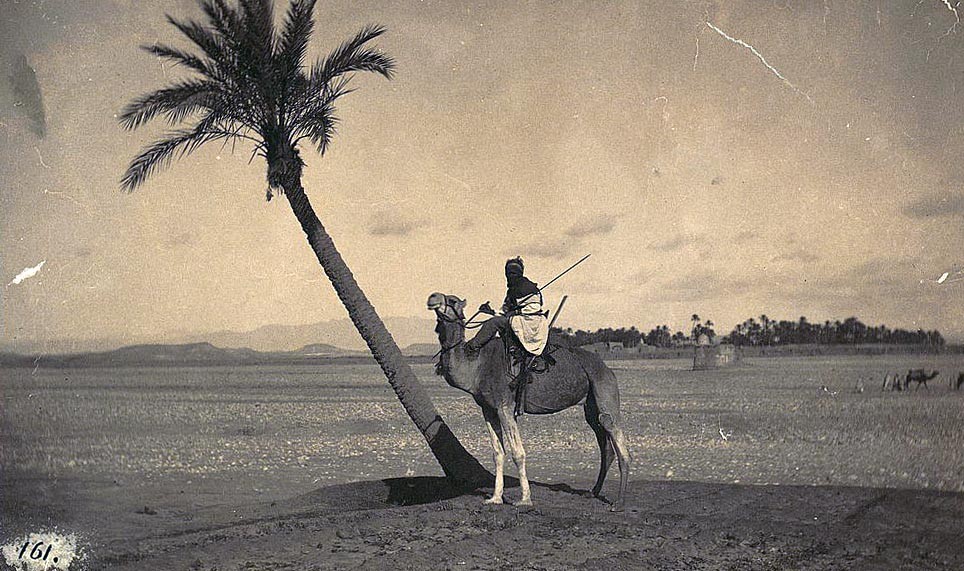
Man on camel next to a slanting palm tree, desert in background. Courtesy of the Library of Congress, LC-DIG-ppmsca-04408.
Lynch in Later Years
Lynch remained in naval service after the expedition. In 1849 he was promoted to commander and resumed his sea-going career. During the years between 1852 and 1861, Lynch explored the West African coastline and sailed in command of steamer USS Allegheny, and sloop of war USS Germantown with the squadron off the coast of Brazil.
In 1861, Lynch, as did his fellow Virginian Matthew F. Maury, resigned his United States Navy commission to join the Virginia Navy. During the Civil War, Lynch (now promoted to Commodore in the Confederate States Navy) commanded gunboats in the North Carolina Sounds, riverboats on the Mississippi River, and the Cape Fear Squadron. Sadly his flagship, the iron clad, North Carolina, sank at anchorage off Smithville, North Carolina. Following the surrender of the Confederacy, Lynch was paroled back to civilian life. William Francis Lynch died in Baltimore, Maryland, on 17 October 1865.
USS Allegheny
After returning from the Holy Land, Lynch received command of the Hunter wheel steamer Allegheny. Problems with the horizontal paddle wheels, mounted amidships on the bottom of the hull, kept her anchored at the Washington Navy Yard and led Lynch to leave the ship. Replacement of the novel paddle wheels with a screw propeller failed to solve the ship’s propulsion difficulties. She became a receiving ship for recruits in Baltimore in 1856, remaining there except for several months’ stay in Annapolis in 1861, and was sold in 1869.
USS John Adams
Lynch sailed on board the sloop of war John Adams in 1853 during his West African exploration trip. Lynch explored and mapped the coastline, but this trip was cut short when he contracted an illness. After his recovery, he produced a report of what he had observed.
USS Germantown
Lynch held his first sea command on board the sloop of war Germantown in 1853-1857. Commissioned in 1847, the 22-gun sloop had served in the Mexican War and as the flagship of the African Squadron. After Lynch commanded the ship in the Brazilian Squadron, it sailed to East Asia to protect American interests there. The outbreak of the Civil War found the sloop in Gosport Navy Yard in Norfolk ready to sail but lacking a crew. Although scuttled to prevent her capture by the Confederates, the ship was raised and had her final service as a floating battery off Craney Island.


